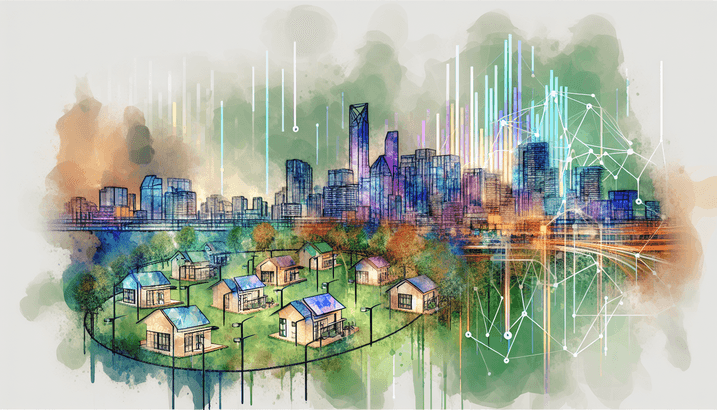Real Estate Market Boom: 7 Explosive Trends You Need to Know
The Influence of Technology on Real Estate
Have you noticed how technology is transforming every industry? Real estate is no exception. From virtual tours to AI-driven property management, technological advancements are reshaping the sector in remarkable ways. For more insights into how technology is disrupting the industry, click here.
Virtual reality (VR) and augmented reality (AR) are no longer just buzzwords. Homebuyers can now walk through prospective properties from the comfort of their current homes. This innovation saves time and helps in shortlisting properties more efficiently.
Artificial Intelligence (AI) is another game-changer. AI algorithms assist in property valuation, predicting market trends, and even in customizing marketing strategies. Do you know why this is important? It enables more accurate pricing, thereby benefiting both buyers and sellers. For more on AI in real estate, check out https://crestnetwork.com/technologies-that-optimize-property-operations/.
Blockchain technology is enhancing transparency and security in real estate transactions. Smart contracts are simplifying the buying process, reducing the need for paperwork, and minimizing fraud.
“The real estate industry is at the cusp of a technological revolution that will redefine how properties are bought, sold, and managed.”
PropTech (Property Technology) platforms offer integrated solutions for property management, helping in lease tracking, maintenance schedules, and tenant communications. Why is this significant? Let’s find out. These platforms enhance operational efficiency, making property management less cumbersome and more transparent. For more details on PropTech, visit Real Estate Services.
Remote Work and Changing Buyer Preferences
The shift to remote work has been a monumental change. How has this affected real estate? Changing buyer preferences are now driving the market trends. More people are seeking homes that offer dedicated workspaces, high-speed internet connections, and outdoor areas.
Remote work has given employees the flexibility to live farther from their office locations. This has resulted in a rise in demand for properties in suburban and rural areas, where larger homes and yards are more affordable.
Why is this shift crucial? Let’s explore. The increase in demand for larger living spaces is pushing developers to design homes that cater to the new needs. Home offices, multi-functional rooms, and expansive outdoor areas are becoming standard features. For more on this trend, see Today’s Market for Multifamily Housing.
Moreover, people are now prioritizing mental health and well-being, leading to an interest in locations with natural surroundings. This trend has compelled urban planners to rethink city planning and prioritize green spaces.
Do you think remote work is a temporary trend? Evidence suggests otherwise. Many companies are adopting hybrid work models, making remote work a permanent feature in many sectors. For more insights on how remote work is shaping real estate, click here.
Urban to Suburban Migration Patterns
Have you observed the changing dynamics between urban and suburban areas? Urban to suburban migration patterns are noticeably shifting, driven by various socio-economic factors. The recent pandemic has expedited this movement, but it has always been in the making.
Why are people moving to the suburbs in droves? A combination of factors including lower cost of living, better quality of life, and increased sense of security are motivating this migration.
Suburban areas offer more space for the price, which is appealing for families looking for larger homes and more outdoor space. Additionally, improved transportation and telecommunication infrastructure make commuting and remote work feasible from these locations.
Another reason is the increasing availability of amenities in suburban areas. From shopping centers to healthcare facilities, suburbs are no longer void of essential services. Developers are keenly observing these trends and responding by building mixed-use developments that offer both residential and commercial spaces. For more on suburban amenities, see Innovation in Mixed-Use Industrial Parks.
Are urban areas losing their charm? Not necessarily. However, the balance between urban and suburban living is shifting, and this trend is expected to continue as people re-evaluate their priorities.
Investment Opportunities in Emerging Markets
Are you on the lookout for lucrative investment opportunities? Emerging markets are presenting exceptional investment prospects in real estate. With rapid urbanization and economic growth, these markets promise high yields and significant capital appreciation.
Countries in Asia, Africa, and South America are undergoing massive infrastructural developments. Cities like Bangalore, Nairobi, and São Paulo are attracting foreign investments due to their booming economies and growing middle-class populations.
Why should you consider investing in these regions? Emerging markets offer affordable entry points compared to developed markets. Though the risks might be higher, the potential returns can be substantially greater.
Can you guess the key factors driving these markets? Increasing urbanization, young populations, and government initiatives aimed at improving living standards are fueling demand for residential and commercial properties. More details about investing in these regions can be found here.
Additionally, technological advancements and improved connectivity in these regions make them even more attractive for investment. Diversification is key in any investment strategy, and emerging markets provide a valuable opportunity for diversifying your real estate portfolio. For a comprehensive guide on maximizing your real estate investments, see Discover How to Maximize the Economic and Social Impact of Your Home.
Sustainable and Green Building Practices
Wondering why sustainability is a buzzword in real estate? Sustainable and green building practices are no longer optional; they are becoming the norm. With growing awareness about climate change, both buyers and developers are prioritizing eco-friendly alternatives. Learn more about sustainability in real estate here.
Green buildings are designed to reduce environmental impact and improve human health. They utilize energy-efficient appliances, sustainable building materials, and incorporate renewable energy sources like solar and wind power.
“Sustainability is not just a trend; it’s a commitment to the future.”
Why are sustainable practices important in real estate? Energy efficiency leads to cost savings in the long run for both developers and homeowners. Sustainable buildings often get higher valuations and are more attractive to eco-conscious buyers. For more on the benefits of green buildings, read Green Globes® Reinforces a Recycler’s Mission and Deepens Sustainability Knowledge.
Do you think green buildings are expensive? Initially, the costs may be higher, but the long-term savings on energy bills and maintenance make them a wise investment.
Additionally, many governments are now offering incentives for sustainable building practices. Tax benefits, grants, and subsidies are available for developers who adhere to green building standards, making it economically viable to go green.
Government Policies and Their Impact
How much do government policies affect real estate? Government policies are pivotal in shaping the real estate landscape. From tax regulations to zoning laws, various policies significantly impact property prices and availability.
Governments worldwide are implementing policies to make housing more affordable. Subsidies for first-time homebuyers, affordable housing schemes, and interest rate reductions are helping to stimulate the market. For more on government policies, see Real Estate Law and Insurance.
Zoning laws and land use regulations also play a crucial role. They determine what can be built and where, influencing property values and urban development.
Sustainable development policies are another focus area. Governments are encouraging green building practices through incentives and by setting stringent environmental standards. This ensures that future developments are not only modern but also environmentally responsible.
Are all policies beneficial? Not always. Some policies can have unintended consequences. For example, rent control laws aimed at making housing affordable can sometimes discourage investors, reducing the overall housing supply. For a discussion on the impacts of rent control, see Lease Concessions and COVID-19.
In conclusion, government policies act as both catalysts and barriers in the real estate market. Staying abreast of these changes is crucial for anyone involved in the sector, from investors to developers and homebuyers.
Concluding Thoughts on Market Explosions
Do these trends indicate the future of real estate? Absolutely. The real estate market is experiencing significant transformations driven by technology, changing buyer preferences, and socio-economic shifts.
Technological advancements are making transactions seamless and properties more accessible. Remote work is influencing where people choose to live, while suburban areas are becoming increasingly attractive. Investment in emerging markets offers vast potential, and sustainability is no longer optional but essential.
Government policies will always play a crucial role in shaping the market dynamics, either by encouraging growth or serving as a regulatory barrier. Staying informed about these policies can give stakeholders a competitive edge.
“The real estate market is not just evolving; it’s exploding with opportunities.”
Are you ready to ride the wave? Understanding these trends will help you make informed decisions, whether you are a buyer, seller, investor, or developer. The future of real estate is bright, and these explosive trends are just the beginning.




